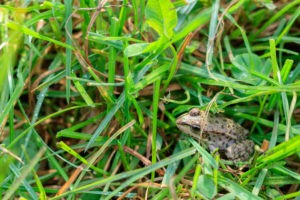They were fun to chase as a kid. Their sounds soothe us as adults on the wooded hiking trails. But when they are invading your yard to the extent you cannot avoid them with the lawnmower, frogs have to go. If there was any question, the dirty looks from your kids for slaughtering Kermit’s friends should seal the deal. Here is how to get rid of frogs.
Grass Length
Long grass traps moisture and allows for good breeding and living conditions for frogs. Trimming the grass short will decrease the moisture content of the soil and diminish the staying value for resident frogs.
Drainage Ditches
Heavy summer rains or wind are likely to carry debris into drainage paths around properties. These small blockages cause water to pool in certain areas creating microhabitats for frogs. It doesn’t take very much space for a significant number of frogs to start flowing out of this blockage area. If frog populations are increasing, inspect drainage routes around the home and yard.
Ponds and Lakes
Ponds and lakes abound in Minnesota, but that doesn’t mean that Kermit and all his friends have to be around in abidance. The following 3 things will help keep the frog populations from springing to life around you:
-
- Vegetation – as much as able keep the vegetation around the water short and controlled. In instances where you are not able to change the vegetation situation, add a barrier between your yard and the preserve.
- When able, add fish to the water. Fish that naturally live in those areas will be happy to snack on the excess frogs developing in the pond or lake.
- Water features that keep the water churning and unsettled create a less desirable habitat for frogs.
Frog Exclusion
Frogs may mistakenly enter a home through sump pump drainage pipes. Placing a wire covering over the end will allow water to flow out while stopping the frogs from coming in.
Fences can be a helpful tool in blocking migrating frogs. It doesn’t have to be overly tall, but it is important that it is buried at least a few inches underground to ensure an animal doesn’t dig underneath it. It is also important that the fence structure not contain gaps large enough for a frog to pass through. A fence can be expensive, but in some cases, it may be the only way to stop frogs from flowing freely into a specific area.
Frogs Under Structures
Anything that blocks sunlight in a moist area can create a happy camping spot for frogs. This could be a deck, a porch, or the structure itself. Frogs prefer ponds and tall grass, but a soft and muddy environment will provide plenty of food and comfortable living for them.
Hot Water
Frogs like a specific range of temperatures to live in. If you have the option, spraying the yard with hot water in the evening when they are most active can drive frogs out of a yard.
Take Their Food Away
As with all animals, take away the food and they will go somewhere else. Since frogs feed on insects, completely removing their food source is impossible, but having a solid pest control program in place will help keep the frog population down. Learn more about what kind of insect control program would be best for your property at rovepestcontro.wpengine.com.

